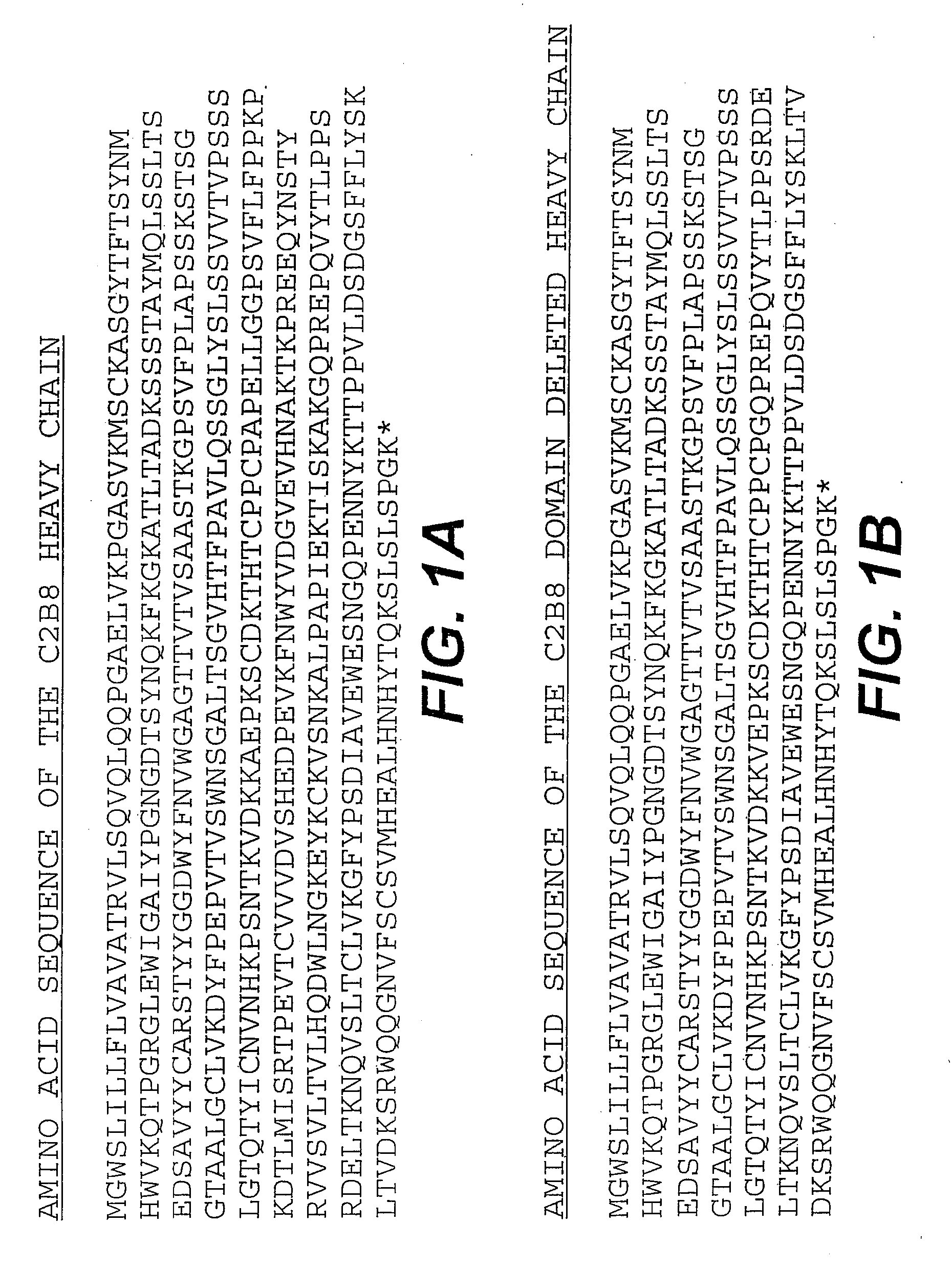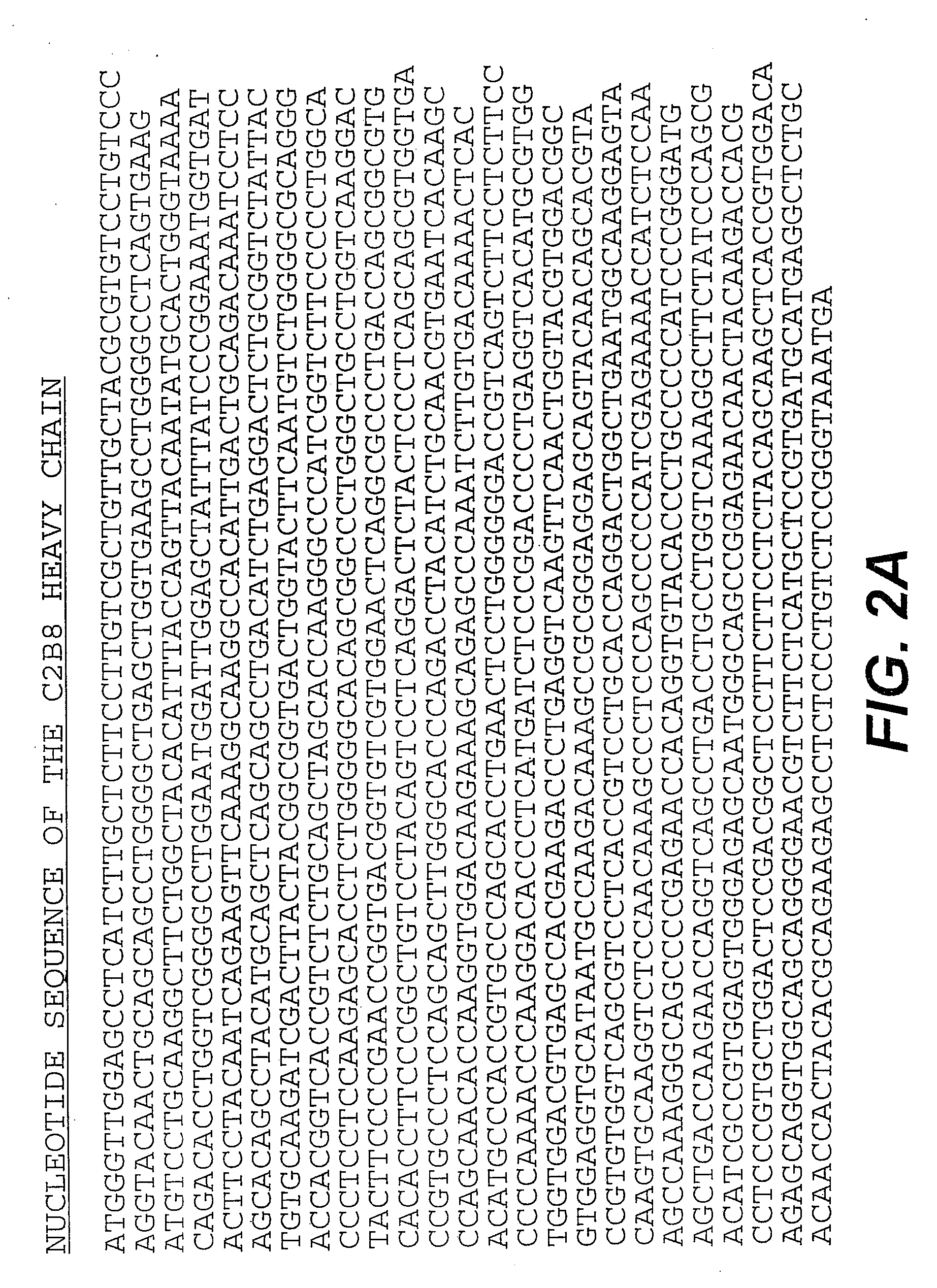Modified antibodies and methods of use
a technology of immunoglobulins and modified antibodies, which is applied in the direction of drug compositions, peptides, nuclear engineering, etc., can solve the problem of myelotoxicity, the dose limitation toxicity of radiolabeled antibodies, etc., and achieves effective tumor localization, rapid blood clearance, and reduced associated toxicity
- Summary
- Abstract
- Description
- Claims
- Application Information
AI Technical Summary
Benefits of technology
Problems solved by technology
Method used
Image
Examples
example 1
Construction and Expression of a C2B8.ΔCH2 Immunoglobulin
[0123]The chimeric antibody C2B8 (IDEC Pharmaceuticals) was modified to create a domain deleted version lacking the CH2 domain within the human gamma 1 constant region. C2B8 and the plasmid N5KG1, which is an “empty” vector encodes a human kappa light chain constant region as well as a human gamma 1 constant region, are described in U.S. Pat. Nos. 5,648,267 and 5,736,137 each of which is incorporated herein by reference. Creation of a CH2 domain deleted version was accomplished by way of overlapping PCR mutagenesis.
[0124]The gamma 1 constant domain begins with a plasmid encoded Nhe I site with is in translational reading frame with the immunoglobulin sequence. A 5′ PCR primer was constructed encoding the Nhe I site as well as sequence immediately downstream. A 3′ PCR primer mate was constructed such that it anneals with the 3′ end to the immunoglobulin hinge region and encodes in frame the first several amino acid of the gamma...
example 2
Construction and Expression of a huCC49.ΔCH2 Immunoglobulin
[0126]A humanized version of the CC49 antibody (ATCC No. HB 9459) was obtained from the National Cancer Institute. The light chain was encoded in a plasmid referred to as pLNCX II HuCC49 HuK. The Heavy Chain was encoded in a plasmid referred to as pLgpCX II HuCC49G1.ΔCH2.
[0127]The light and heavy chain variable domains only were isolated from these plasmids by PCR amplification. PCR primers were constructed such that restriction endonuclease sites were included allowing subsequent subcloning into IDEC's proprietary expression vector N5KG1.ΔCH2.
[0128]The light chain restriction enzymes were Bgl II at the 5′ end (immediately upsteam of the translation initiation codon for the natrual leader peptide encoded by the NCI plasmid) and BsiW I at the 3′ end (in translational reading frame with IDEC's vector encoded human kappa light chain constant domain. No amino acids within the light chain variable domain were changed from the NCI...
example 3
Construction and Expression of a C5E10.ΔCH2 Immunoglobulin
[0133]Murine C5E10 expressing hybridoma cells were received from the University of Iowa. RNA from the cells and then made cDNA using oligo dT from the RNA. The cDNA was PCR amplified using a series of mouse kappa and heavy chain variable region primers. The PCR products were run on agarose gels. Using known techniques, primers were used to isolate and identify the light and heavy chains as bands in the agarose. The bands were isolated, cut with restriction enzymes and the light chain variable region was cloned into Neospla N5KG1 vector substantially as described in Examples 1 and 2. The heavy chain variable regions were then cloned into a Neospla ΔCH2 vector (also substantially as described in Examples 1 and 2) in order to generate an antibody missing the CH2 domain. The DNA and amino acid sequences of the heavy and light chain variable regions of the parent antibody and the domain deleted construct were sequenced as shown in...
PUM
| Property | Measurement | Unit |
|---|---|---|
| concentration | aaaaa | aaaaa |
| pH | aaaaa | aaaaa |
| concentration | aaaaa | aaaaa |
Abstract
Description
Claims
Application Information
 Login to View More
Login to View More - R&D
- Intellectual Property
- Life Sciences
- Materials
- Tech Scout
- Unparalleled Data Quality
- Higher Quality Content
- 60% Fewer Hallucinations
Browse by: Latest US Patents, China's latest patents, Technical Efficacy Thesaurus, Application Domain, Technology Topic, Popular Technical Reports.
© 2025 PatSnap. All rights reserved.Legal|Privacy policy|Modern Slavery Act Transparency Statement|Sitemap|About US| Contact US: help@patsnap.com



